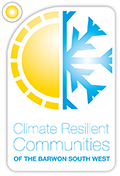The Region has its own unique characteristics. The following profile provides a snapshot of the social, economic and environmental nature of the Region and is important in providing context for the risks and opportunities that have been identified. It also assists with the interpretation of the findings from the vulnerability assessment - social, environmental and economic sensitivity and adaptive capacity, for the Region.
Table 2 below provides an overview of key information for the Region including characteristics of local demographics, the natural and built environment and the economy.
| Characteristics | Information |
|---|---|
Overview
|
The Region is located in the south west of Victoria, Australia. It stretches from the tip of the Queenscliff heads at Port Phillip Bay in the east to the border of South Australia in the west, and from the Southern Ocean coastline up to the southern tip of the Great Dividing Range in the north. The region is home to approximately 350,000 people and includes some of Victoria’s fastest-growing municipalities, including the City of Greater Geelong, Victoria’s second-largest city by population, and the key regional centres of Warrnambool, Portland, Hamilton and Colac. |
Natural environment (physical)
|
The Region spans over 3.2 million hectares and is characterised by a varied natural environment which is home to some of Australia’s most unique and rich landscapes. It features nearly 40 per cent of Victoria’s coastline, which may expose the Region to significant adverse impacts due to sea level rise and erosion caused by extreme climate events. This risk may be compounded by the social and economic importance of the Great Ocean Road, which runs along the length of the Region and which is a significant tourist drawcard to the area. The Region contains a range of national parks, state parks, forest parks and reserves including the Great Otway National Park, Grampians National Park, Lower Glenelg National Park, Mt Eccles National Park and the Brisbane Ranges National Park. Each of these reserves support a range of threatened species and vegetation community. The Region also contains many valuable wetlands, including the RAMSAR-listed Lake Corangamite. |
Social environment (community)
|
Approximately 52 per cent of the regional population live in urban areas and the remainder in rural areas. Population is forecasted to remain relatively constant over the next decade, although the eastern parts of the Region are expected to experience strong population growth as people establish ‘lifestyle properties’ within easy commuting distance of major regional centres such as Geelong, Torquay and Warrnambool. The Region displays an ageing population profile, and the population distribution is skewed by the loss of rural youth to urban centres pursuing educational and employment opportunities. There are also pockets of entrenched disadvantage in the Region, and overall the Region has lower income earners than the Victorian average. Although the Region has relatively high employment levels, Year 12 completion rates are lower than the Australian regional average and the Region has a higher proportion than average of people requiring day-to-day assistance due to a disability. Low performance against these socio-economic indicators may indicate a potential difficulty to adapt to more frequent extreme weather events into the future. |
Built environment
|
The vast majority of the housing in the Region is separate housing, owing to the predominantly rural profile of the Region. In terms of infrastructure, the Region has numerous road transport links to other parts of the country via the Princes Highway, Hamilton Highway and Glenelg Highway. The Region also has a standard gauge rail network linking Geelong to other major centres and the Avalon Airport near Geelong which has obtained approval to support international services. There are established industrial centres at Geelong, Warrnambool and Portland. Bulk ports in Geelong and Portland enable the Region to process and handle oil, grain, woodchips, alumina, mineral sands and fertiliser. Major health and educational facilities such as Deakin and RMIT universities and other vocational colleges are located throughout the Region. |
Economy
|
The Region is underpinned by a strong agricultural sector. Dairy in particular is responsible for 50 per cent of the Region’s exports, accounting for about 23 per cent of the gross regional product and 25 per cent of Australia’s overall dairy production. Other agricultural activities in the Region are also significant, such as forestry, which provides 20 per cent of Australia’s forestry plantations. Along with forestry and fishing, agriculture accounts for approximately 9 per cent of regional employment. Manufacturing is also a major industry. The major export from the Region is aluminium, which is smelted and shipped at Alcoa’s two refineries located at Point Henry and Portland. Other significant manufacturing in the Region is in the processing of primary products and resources, particularly dairy, seafood and meat processing. Other major industries in the Region include tourism, retail, energy, construction and health care and social assistance. |
Table 2: Regional profile
The regional profile provides important contextual information on the Region. It also provides a deeper understanding of the project outcomes in terms of the risks and opportunities identified as well as the sensitivity and adaptive capacity of particular geographic areas.
About the Barwon South West
A leading approach to adaptation








